When you think about learning Spanish, do you see images of textbooks and classrooms or premium software that arrives in a shiny box? If so, you might also see dollar signs — there’s no doubt that learning a language can cost some serious money.
Fortunately, times have changed — and language learning along with them. At ALR, we’ve tried out hundreds of resources both good and bad, many of which are free. The number of available free resources is a definite advantage to the frugal-minded language learner.
This post will explore the idea that it isn’t necessary to spend any money on your Spanish-learning journey. If you’ve got an internet connection and the motivation, you’ve got all you need for practice with all language skills: speaking, listening, reading, and writing.
Read on to discover an incredible number of worthwhile, free language tools.
Choosing the Right Resources
The variety of resources out there may be daunting at first glance, but choice is a good thing. Some of the most effective resources are those that specialize in one specific skill, and different types of study methods will appeal to different learners.
We’ve organized some highly effective free resources by type below — whether you’re after a structured course, reading materials, videos, podcasts, or someone to chat with, we’ve got you covered.
Courses
The resources in this category have clear structure and are designed to guide you to a higher level of Spanish, step by step.
If you have trouble deciding what to study and would like to be shown the way, these courses could be what you’re looking for. With a variety of practice activities in most courses, your Spanish skills will get a well-rounded workout.
ALR Curated Spanish Course

This is our very own course — it’s free to use and ready to take you to the next level in your Spanish journey. We’ve matched quality materials from all over the internet with our own thorough curriculum to provide instruction and practice in all language skills.
This course draws from our experience with a large number of different resources, and the multiple types of content we’ve included in every lesson cater to a variety of learning styles. You’ll find videos, articles, websites, audio, and interactive activities organized in a logical fashion.
Extras like comprehensible input, cultural content, and language-learning advice accompany quizzes, flashcards, and speaking and writing prompts for a complete learning experience.
Language Transfer
The brainchild of Mihalis Eleftheriou, Language Transfer is a free audio course. It’s a strong option for beginners looking to build a foundation in Spanish. The episodes feature recordings of lessons between Mihalis and a student that you can listen in on and participate as if you were there.
This course could be an especially good option for aural learners and those interested in learning useful patterns for thinking their way through Spanish. Read our full review.
Duolingo
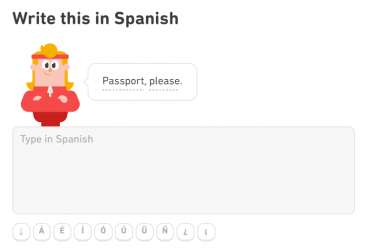
In terms of popularity, Duolingo might be at the top of the list. It’s available in an incredible number of languages and is fun to use. The short, gamified activities in Duolingo are great for making study engaging and convenient, but it probably isn’t the fastest way to improve your skills.
Duolingo is likely best for learners looking for a convenient way to supplement their study with additional vocabulary practice. Note, however, that you’ll need to use the browser version to reliably get practice typing in your answers and improving recall. Read our full review.
Coursera and EdX

Both of these platforms are potentially great choices for learners interested in free university-style courses. Each site includes courses developed by accredited universities and offers optional paid certificates of completion.
In addition to courses teaching the Spanish language, advanced learners will be able to take courses covering other subjects taught in Spanish.
All of the courses on EdX are available to audit for free, while some of the Coursera courses require payment. The courses you find on EdX may also be more comprehensive. Read our Coursera mini review and our EdX mini review.
OpenLearn

Spanish courses on OpenLearn are completely free and are available at all levels, though absolute beginners may find it challenging to keep up at first. Courses usually have a specific focus, and you may need to look elsewhere for sufficient practice with conversational Spanish. Read our mini review.
1001 Reasons to Learn Spanish Repaso 1
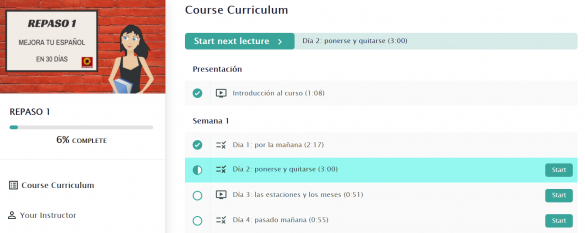
This free course was created by Juán Fernandez, an enthusiastic Spanish teacher from Spain. His course, Repaso 1, is intended for learners of Spanish at a lower-intermediate level looking for a free way to review and boost their skills.
The course includes 30 daily lessons, each of which should take between 20 and 30 minutes to complete. Lessons include videos, text, listening and quizzes. Read our mini review.
Destinos
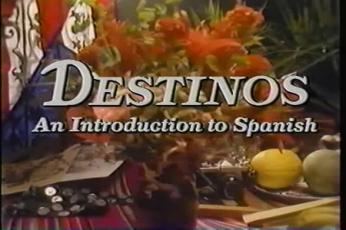
The production value of this video course is a bit dated, but it teaches through immersion, covers a variety of Spanish accents, and includes practice activities. The storyline is engaging, and the course could prove a great introduction to Spanish for learners that like the dramatic backdrop.
Note that the original website may be unavailable in some countries, but the videos can be found on YouTube or the KET Education websites without the additional practice activities. Read our mini review.
Lawless Spanish

There are a ton of free resources on the Lawless Spanish website, but the beginner course is particularly good. It’s a 13-unit course with lessons designed to provide absolute beginners with an understanding of the basics. You can save your progress, download lessons, and take short quizzes to test yourself.
Flow Method

Produced by Idahosa of the Mimic Method, this course is unique to the others in this list because it focuses on pronunciation. Take part in detailed lessons on Spanish phonetics before progressing to units in which you’ll dissect and learn to produce the sounds in various Spanish-language songs.
By the end of this course, you should have a strong understanding of the sounds of Spanish as well as be comfortable producing them.
FSI and DLI

The course created by the Foreign Services Institute (FSI) won’t be winning any beauty pageants, but it’s one of the more thorough Spanish courses you can find for free. The PDF lessons and accompanying audio teach important grammar and vocabulary while also providing a good deal of listening comprehension practice.
Similar to the FSI course, the Spanish materials offered by the Defense Language Institute make up for their dull appearance with thorough instruction. The content is largely similar to the FSI course, but higher levels may see some military-oriented vocabulary. Read our FSI mini review and our DLI Mini review.
YouTube and Video
More than just cat videos and free music streaming, YouTube is an effective platform for getting language practice. There are plenty of channels created by language teachers and learners alike that teach various aspects of Spanish.
The sheer number of viable YouTube channels for learning Spanish is incredible. You’ll find some great video sources below, but be sure to check out our list of YouTube channels for learning Spanish to find the best one for you.
Butterfly Spanish
Butterfly Spanish is a channel hosted by Ana, a Spanish teacher who creates focused video lessons for learners of many levels. Beginners will probably find the most relevant material on this channel.
Ana makes frequent use of a whiteboard and goes into detail with pronunciation, grammar, and additional practical tips.
Dreaming Spanish
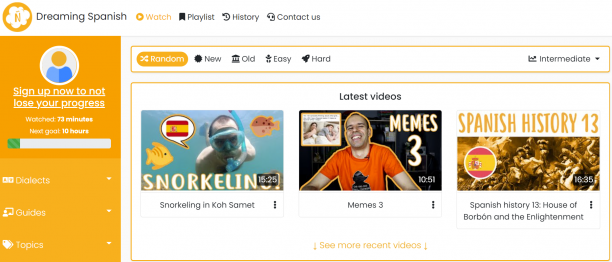
Pablo’s project, Dreaming Spanish, makes use of videos with comprehensible input to provide learners with authentic Spanish experiences. Gestures, slow speech, and simplified vocabulary are used to tell stories that are appropriate for learners at a variety of levels.
There’s a ton of content for beginner and intermediate learners, and levels are clearly marked with each video. Read our mini review.
Español con Juan

These videos are better suited to learners at the upper-beginner and intermediate levels. Juan is a charismatic teacher from Spain who uses humor to make lessons interesting.
The channel is built upon the idea that listening to native speakers you can understand is essential to improving your Spanish. Juan’s videos take place in a variety of settings and cover a broad enough variety of topics to stay entertaining.
Other Resources for Learning With Videos
Language Learning With Netflix
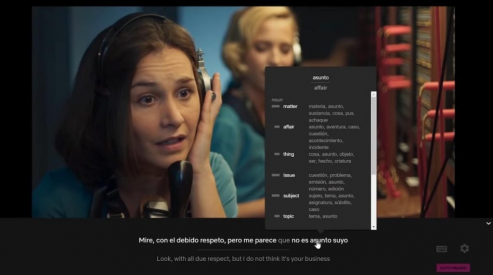
This Chrome browser extension has the power to turn your Netflix sessions into productive language-learning time. The free version allows for bilingual subtitles, plus the ability to skip forward or backward with ease, hover over words for translations, and auto-pause after each sentence.
You can also use the LLN catalogue to find Spanish-language media available in your country. Read our mini review.
CaptionPop
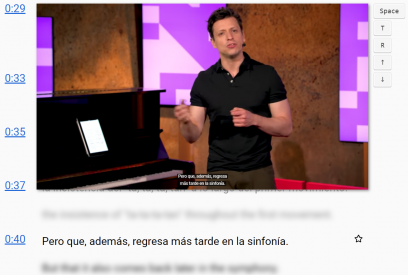
CaptionPop is similar to Language Learning with Netflix in that it uses videos with subtitles to facilitate language practice. Search the CaptionPop website to find videos with both Spanish and English subtitles, and use the navigation tools for efficient study. You’ll have the options to blur subtitles (until you need them) and to pause after each line, among others. Read our mini review.
Podcasts
The audio-only cousin to YouTube videos, podcasts are an equally potent learning method for the right learner. Not only are podcasts generally free, they’re extremely portable and can be used just about anywhere. There’s also a great deal of variety — chances are, there’s one out there that’s perfect for you.
We’ll list some quality options below, but see our full list of stellar Spanish podcasts here.
Coffee Break Spanish
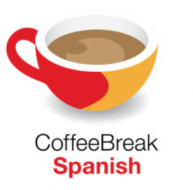
The free podcast episodes from Coffee Break Spanish provide incredible value. Lessons start with the basics and gradually progress up to material at an intermediate level. For great structure and lessons that start from the beginning, this is a great option for aural learners. Read our full review.
Spanish Obsessed
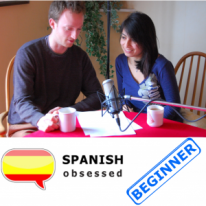
A feature of this podcast that sets it apart from many is that one of the hosts is from Colombia, and the other is from London. Especially for lower-level learners, it can be helpful to compare how the two speak differently, as well as hear the occasional correction.
Episodes are full of natural conversation and cater to learners at all levels. Find the episodes for free on major streaming platforms.
Reading for Free
Reading practice can be easy to neglect while learning a language, but reading in Spanish at the right level can be seriously productive. Two practical ways to go about getting reading practice in a foreign language are graded readers and reading tools.
Graded readers are simply pieces of text that contain vocabulary and grammar structures that match a certain level of difficulty. Reading tools can facilitate better understanding of a text by providing translations of individual words or whole sentences.
We’ll list some of each below, but see our Spanish Comprehensible Input Library for tons of reading material at a level that’s appropriate for you.
Readlang
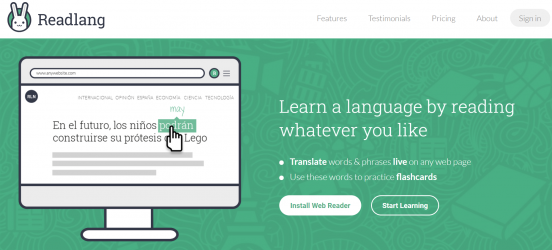
Readlang is a browser extension with the potential to turn all of your internet experiences into learning opportunities. It enables instant translations with the click of your mouse on any Spanish-language web page and saves the words you look up for later practice via SRS and flashcards.
The free version of this extension doesn’t include all of the features that are available with a premium account, but it’s still a powerful tool. Read our mini review.
OPLingo
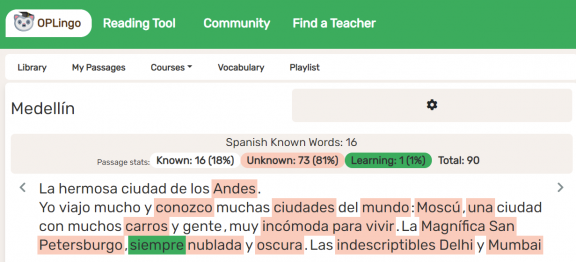
Like Readlang, OPLingo offers a reading tool that is free to use and potentially very useful. Search the library of texts by level or title to find reading material that’s right for you or upload your own text to make use of the mouse-over OPLingo translations.
The free version allows for uploading 15 of your own texts and for saving up to 20 words as “learning.” Read our mini review.
Lingua
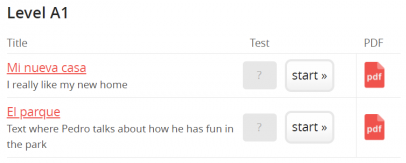
This is a great place to find free texts for reading practice at a variety of specific CEFR levels. These readings are relatively short and deal with topics such as culture, places, and routines. A nice extra feature offered here are multiple-choice quizzes that accompany each reading. Read our mini review.
Progress with Lawless Spanish and Kwiziq
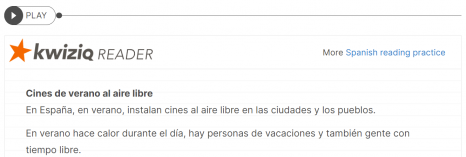
This is another site with short, level-specific texts for reading practice. The content here comes with audio narration and tags describing which grammar concepts are covered in each text. You can also click on any phrase to reveal a contextual translation, but you won’t find quizzes for checking comprehension.
Skill Practice
A central element of a successful language learning effort is practice — lots of it. Practice can take all sorts of shapes and sizes, from pronunciation drilling and flashcard quizzing to full-on conversation practice.
The resources in this section are great for focused practice in a variety of specific areas. You’ll need more than any of these individual tools to learn Spanish, but they can prove instrumental in helping you make progress.
Speechling
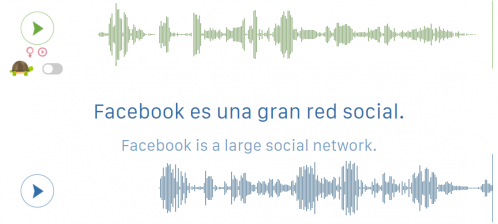
This is a fantastic tool for learners looking to improve their Spanish pronunciation. Here you can record yourself speaking and get feedback from a real Spanish teacher. A free Speechling membership grants ten monthly recordings, but you’ll be able to get plenty of practice mimicking native-speaker pronunciation. Read our full review.
Clozemaster
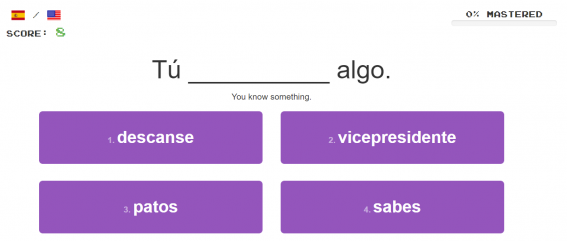
For free vocabulary practice with an 80s arcade vibe, Clozemaster fits the bill. The site makes use of gamification while quizzing learners on vocabulary as it appears in context, SRS style.
Seeing words as they’re used in real sentences can help learners attain a practical understanding of the language quickly and naturally. Read our full review.
Conjuguemos
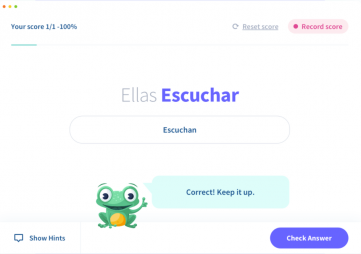
This free site is a practical tool for learners interested in an engaging way to practice all things verbs. As the name implies, verb conjugation takes center stage in most of the games on this website, but you’ll also be able to find vocabulary practice. Read our mini review.
LyricsTraining
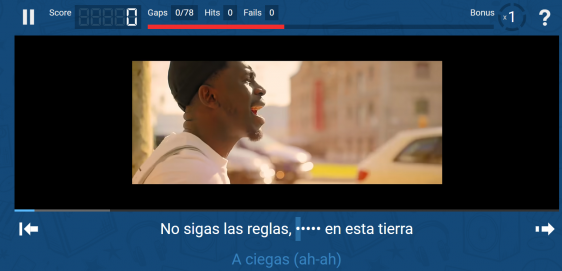
This free app offers one of the more fun ways to practice a language, especially for the musically inclined.
With LyricsTraining, you’ll listen to songs in Spanish and be tasked with completing the lyrics either by selecting the correct answer or typing it in yourself. Note that typing out answers is only available in the browser version and not in the app.
Overall, this is a fun way to improve your listening skills while jamming to your favorite tunes. Read our mini review.
Kwiziq
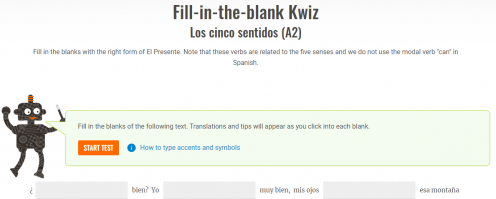
A basic account with Kwiziq is free and grants access to 10 quizzes each month. This isn’t enough quizzes for it to become your primary study method, but there are also a bunch of well-structured, thorough grammar lessons. The quizzes can be quite informative as they suggest which grammar lessons to take, based on your performance.
The free placement test is also particularly good — use this resource for grammar lessons and the occasional quiz. Read our full review.
Anki

Anki is probably the most customizable and powerful free way to study vocabulary. The app may not be the most visually appealing — and there is a bit of a learning curve — but it takes full advantage of spaced repetition to allow for super-efficient vocabulary practice.
Create your own personalized study deck with audio files, translations, fill-in-the-gap exercises, and images, or download one of the many user-created decks. The browser version and Android app are free to use; the Apple version of the app is $25. Read our mini review.
Reference
A large part of learning any language is the questions you’ll have along the way. There will be plenty of questions and doubts, and having a couple of go-to resources for reliable information can have a huge impact on your learning experience.
Use the resources in this category for quick translations, verb conjugations, grammar explanations, correct pronunciation, and more.
SpanishDict
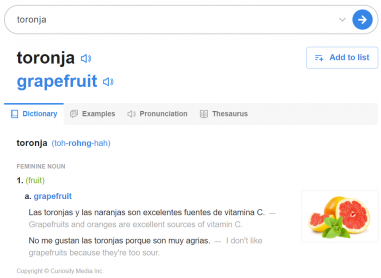
SpanishDict is a superb dictionary for learners of Spanish; in fact, it’s hard to think of any reasons not to use this resource regularly. Each translation and definition comes with a large number of bilingual example sentences, pronunciation information, word type, similar words, and even images.
There are also extra features like flashcards, quizzes, videos, tongue twisters, and more. Read our mini review.
WordReference
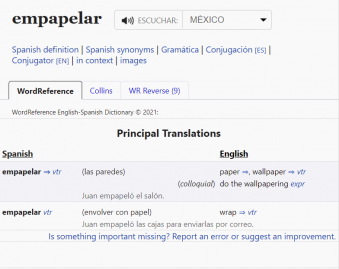
This is an excellent source of translations for single words in a variety of languages — those between English and Spanish are particularly good. Each translation provides extra information like word type, gender, example sentences, and pronunciation.
Wordreference also hosts language forums where you can ask questions related to learning Spanish and answer those related to your native language. Read our mini review.
Lingolia

This site is super convenient for quick, thorough rundowns of various aspects of Spanish grammar. If you want to see a comprehensive overview of pronouns, adverbs, tenses, sentence structure and more, this is a solid place for quick references.
Linguee

Machine translations aren’t always accurate, and it can be difficult to find any translation at all for specialized vocabulary or slang. In these cases, a resource like Linguee can be of great use.
Linguee sources instances of the word or phrase you’re looking for from billions of online translations, highlighting how it’s been translated before. Read our mini review.
Forvo

Forvo is a solid resource for learners seeking pronunciation examples. Native speakers from around the world can record themselves speaking and upload it to Forvo. This can be particularly useful for learners of Spanish that are interested in hearing how a word is pronounced by speakers of a specific country. Read our mini review.
YouGlish
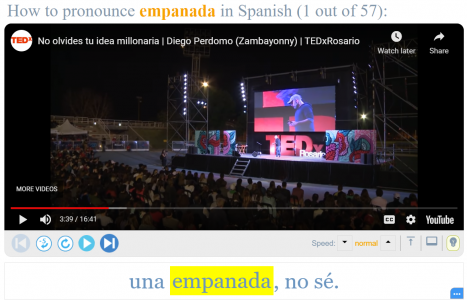
YouGlish is an interesting website for learners that would like to see and hear a word as it’s naturally used in context. After entering in a Spanish word, the tool sources videos from YouTube that include that word.
It’s an effective method for listening to authentic uses of the word in a variety of contexts, and you just might find some great videos while you’re at it. Read our mini review.
HiNative

For answers to questions that can’t easily be answered by a quick internet search or in a dictionary, HiNative is a great place to look. The site is used by a large community of language learners that ask and answer each other’s questions.
You may notice that Spanish (Mexico) is the only variety of the language that appears on the homepage search box, but answers to questions from many different Spanish-speaking countries are available.
If you’re curious about the most natural way to ask someone out in Colombia or what the lyrics to your favorite reggaeton song are really about, try asking someone on HiNative. Read our full review.
Community
It’s easy for language study to become a solo endeavor, but some would argue that communication with others is what it’s really all about. Communicating with others can be immensely rewarding, informative, and productive.
Whether you’re looking for feedback on your writing or speaking skills or you’re just looking to chat, there are quite a few free tools out there.
Language Exchanges
HelloTalk and Tandem

Both of these resources are high-quality tools for finding language-exchange partners. In each, language learners from around the world seek others that are interested in practicing language together.
You’ll be able to find plenty of people to practice Spanish with through text, voice calls, and even video chats. Built-in language tools like translations and corrections facilitate smooth communication and learning opportunities.
The aesthetics are the main differences between these two apps, so take a peek to see which appeals to you, or read our comparison post. Read our full HelloTalk review and our Tandem review.
Lingbe

Another language-exchange app, Lingbe focuses on spoken communication. Instead of taking the time to create a profile and browse other profiles to find the right language partner, you’ll get to practice speaking right away with another random language learner.
Help other learners practice your native language in order to earn credits that can be used to speak with fluent Spanish speakers. Read our mini review.
Polyglot Club

This growing community of language learners is free to join and spans the globe. The site provides opportunities for learners to meet in person or online for language exchanges, find language exchange partners, ask specific questions, and get corrections on their writing.
You could make the most of this resource by offering to help others learn your native language and build relationships with other learners.
Duolingo

Duolingo has a neat online events feature for learners that are looking to practice speaking different languages with other people. There are plenty of events happening at all times, and they could make an enjoyable way to get face-to-face speaking practice. Events are free, often happen over Zoom, and include multiple people. Read our full review.
Getting Feedback
Journaly
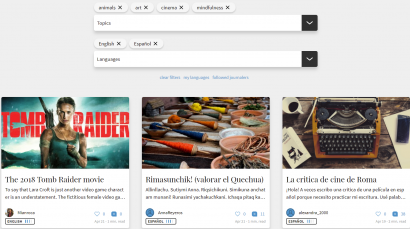
If you’re looking to make regular writing practice a part of your language-learning efforts, there’s no other resource quite like this. To use Journaly, simply write about anything at all in your target language and sit back while other members proficient in the language offer corrections.
What sets this tool apart from others is its effortless, intuitive design, and the ease with which you can offer and receive corrections. Be sure to provide corrections to others in order to pay it forward!
LangCorrect

If you’re looking for feedback on your Spanish writing skills, LangCorrect is definitely a resource worth checking out. It’s free to use and is run by a community of language learners that offer feedback to each other. You can support the community by offering feedback on the writing of learners of your native language. Read our mini review.
OPLingo

Like LangCorrect, OPLingo is a resource that Spanish learners can use to get free feedback on writing. The community is still growing here, but those looking for help with their Spanish are likely to find plenty. Read our mini review.
italki Community
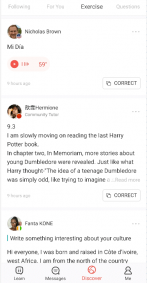
italki is a massive online tutor marketplace, but it’s also got some nifty extra features. The community section of the italki app is a great place for learners to find feedback on their writing and speaking skills. Simply post something you’d like feedback on and other users will likely provide speedy feedback. Read our full review.
Busuu

Busuu is a complete course that you’ll need to pay for in order to get full access, but it also boasts a unique community feature that’s free to use. Learners can submit answers to speaking and writing prompts to get feedback from others that are proficient in your target language. The need to respond to prompts makes this option slightly more limited than other feedback sources. Read our full review.
Meeting in Person
Meetup

This site is a good option for people interested in speaking with other language learners in person. It can be one of the most rewarding and enjoyable ways to practice Spanish, especially if you’re interested in meeting new people.
Language Meetup events are available in many major cities and often take place at restaurants, bars, or other public venues. While many events are free, some may ask for a monetary contribution in order to cover organizer costs.
Language Discussions

There are communities of users for just about any topic on Reddit, Spanish included. Discuss the finer points of the subjunctive mood, share Spanish-language memes, talk about study techniques, goals, motivation, or really anything else related to learning the language.
LLORG

This forum has an active community of learners of several languages. There are areas of the site in which you can sign up for language challenges, join study groups, share your progress, ask questions, share your favorite study resources, and more.
Testing Your Knowledge
In order to monitor your progress, it can be helpful to evaluate your level from time to time. One of the more reliable ways to do this is to use standardized tests. The CEFR (Common European Framework of Reference for Languages) scale runs from A1 to C2 and is the most common method for measuring language ability.
CEFR Placement Tests
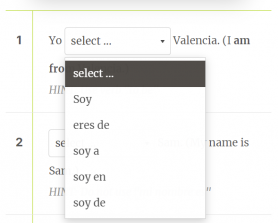
Searching the internet for “free Spanish placement tests” will return a large number of results, but some are certainly better than others. You’ll need to sign up with an email address, but the Kwiziq and Lengalia placement tests are quite thorough.
The Kwiziq test places a heavy emphasis on grammar, while the Lengalia tests a wider variety of skills, including listening.
Practice DELE Exams
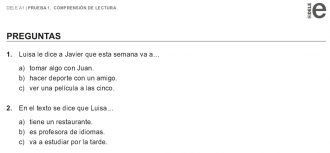
While you may have no interest in ever taking the DELE exam, it is a thorough measure of Spanish ability and can be a useful tool for getting accurate feedback on your level. The Instituto Cervantes offers the materials from previous exam periods for free practice.
Other Tips for Free Access to Paid Resources
Check Your Local Library
Just because the internet is so readily available doesn’t mean that you should overlook your local library. It could make a viable resource for finding language study materials. In addition to offering a variety of language books, many libraries also grant patrons access to language-learning programs.
Mango Languages is one of these; it’s a course that’s best for learners at lower levels that are interested in some focused vocabulary practice. Read our Mango Languages review.
Another resource you may be able to access for free with a library membership is Kanopy, which has a video course for learners starting out with Spanish.
Language software giant Rosetta Stone also offers its courses through some libraries, so check to see whether you have access if you’re interested in its famous immersion method. Read our Rosetta Stone review.
In Closing
Cost may have once been a common barrier for many language learners, but there are now an inspiring number of ways to learn Spanish without spending a dime. Hopefully, this post has pointed you in some seriously useful directions and brought you closer to accomplishing your goals.
Read some of our other posts if you’d like to learn more about how to learn Spanish with podcasts, YouTube channels, courses, or apps.

